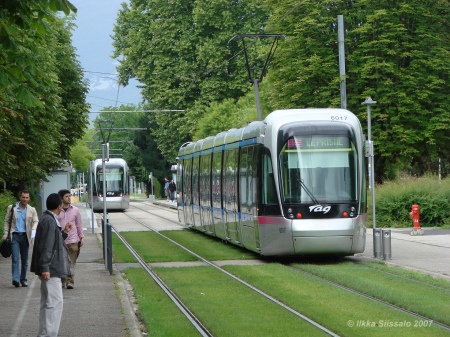
With Bombardier’s two Flexity Outlook trams arriving in Vancouver, let’s take a look what the other companies have to offer for trams for the 21st century.
Siemen’s Combino modular car
The Combino is a low floor tram made by Siemens Transportation Systems and first model came off the assembly line in 1996 at the Duewag works in Düsseldorf, Germany. Because of its modular design using standardized components, resulting reduced costs, the Combino was for a time one of the most successful tram types on the market. They were sold to twelve transportation operations and a further development was sold to two others. In 2007, a new generation of Combinos was sold to Berne. The Combino line of modular trams is expected to be superseded by Siemens with new line of trams called Avenio, which have been built on the design technology of Combino.
The tram is largely made out of aluminum, with a welded under-frame to which the body framework is bolted in sections, which means that the Combino can easily be adopted to different lengths, widths and gauges. The length of the trams varies from 19 metres (62 ft) (Nordhausen “Duo” and Melbourne D1) to a world record 54 metres (177 ft) (Budapest), accommodating between 100 and 350 passengers. All versions are designed to have a 300-millimetre (11.8 in) floor height and a 10-tonne (11-short-ton) axle load. It can be built as an unidirectional to bidirectional vehicle with driving positions at both ends, and for TramTrain operation or for operation on unelectrified tracks, the DuoCombino with an additional diesel propulsion system, is offered.
The Combino tram uses (can be adapted for other voltages) 600V DC overhead power and which convert this to 400V 3-phase AC power for the regenerative low wear motors via 3 IGBT PWM inverters. On board controls, lighting and air conditioning run at 24V DC.
In early 2004, Siemens admitted to problems concerning the stability of the car bodies and, as a precautionary measure, instructed all public transportation services to take all Combinos with a service mileage of more than 120,000 kilometres (74,565 mi) out of service. Torsion forces generated in S-curves were much higher than anticipated, leading to cracks around the articulations between the car modules. Subsequently, hairline cracks were found in the joints of the aluminum bodies, which could cause the roof to collapse in the case of an accident.
Siemens launched a three stage process of rebuilding the 454 modules affected, which now reinforces the modules to give an expected 30-year life. The cost of the rebuild programme was put at €400m or CAD $620m.
Over 500 Combino’s have been built and in operation around the world and the Combino tram has now been superseded by the Avenio modular tram.

Budapest's 54m Combino caterpillar tram








